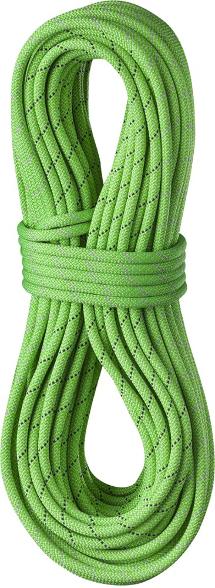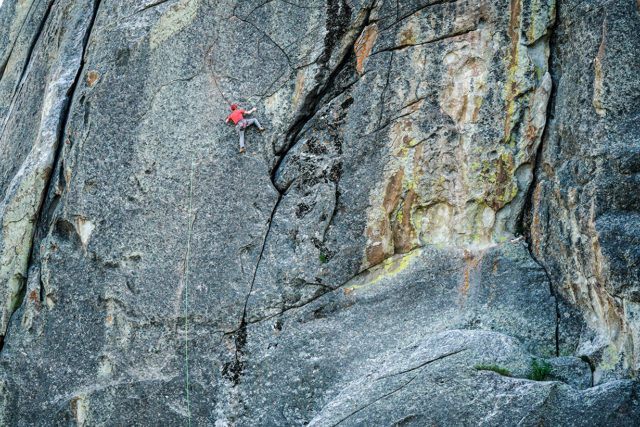
Edelrid Tommy Caldwell ProDryDT
Diameter: 9.6 mm
Rope Type: Single
Sheath-to-core ratio: 40/60
Weight: 62 g/m
Dynamic Elongation: 33%
Static Elongation: 8.1%
Impact Force: 8.9 kN
UIAA Falls: 9
Available Lengths: 60, 70, 80 m
Bicolor Available: yes (only available in bicolor)
Length Tested: 70 m
MSRP: $259 (70 m)
Stated Features
- Thermo Shield treatment for perfect handling
- DuoTec for permanent middle marking
- ProDryDT for outstanding dirt and water resistance
- Water absorption less than 2% as per UIAA Water Repellent Test
- 3D lap coiled so you can use it straight away, without kinking and tangling
Test Locations: Rocky Mountain National Park, Eldorado State Park, Clear Creek Canyon, & Golden Gate State Park, CO; Tensleep, WY; City of Rocks, ID
Days Tested: 30
Intro
Edelrid’s Tommy Caldwell ProDryDT is first and foremost an all-purpose utility rope. At 9.6 mm, it’s right around what you’d want for a well-rounded, do-it-all single line — not so thick that you wouldn’t consider using it for a hard, single-pitch route and conversely not so thin that you’d save it only for those project pitches.
Edelrid’s description seems to market the rope towards more abusive applications: to underscore the rope’s aptitude for Tommy Caldwell’s signature discipline (long routes on large, granite walls), Edelrid says the rope’s “very high sheath proportion makes it ideal for working routes or Big Wall climbing.”
We tested the Tommy Caldwell ProDryDT over the course of an entire season to assess this claim and to provide some insight into the technical aspects of the rope, such as Edelrid’s Pro Dry treatment and the Thermoshield process applied to the rope during manufacturing.
[Note: the name “Tommy Caldwell ProDryDT” is a bit of a mouthful so we’ll be referring to it as the “TC ProDryDT.” ]
Anatomy and Tech Specs
The TC ProDryDT is 9.6 mm in diameter and features a bicolor DuoTec weave, meaning the sheath patterning is different on each half of the rope in order to help make it easier to find the middle of the rope.
The TC ProDryDT’s 62 g/m weight is right around what you’d expect given its 9.6 mm diameter. Black Diamond’s new 9.6 mm Endurance has the same stated weight of 62 g/m, while Edelweiss’ Excess 9.6 is a bit lighter at 59 g/m. The takeaway here is that the TC ProDryDT’s weight is right around the middle of the pack compared to 9.6 mm ropes.
And it’s worth quickly noting that 9.6 mm ropes are currently much less common than 9.5 mm ropes, despite the two being functionally very similar. Consequently, some of the discussion below refers to 9.5 mm ropes. For reference, 9.5 mm and 9.6 mm are 100 microns apart in terms of diameter, and that line blurs once the rope is used, stretched, and worn. Beyond the spec sheet, it’s very hard (bordering on impossible) to tell the difference between a 9.5 mm and 9.6 mm rope in the field.
The TC ProDryDT, as the name suggests, bears Edelrid’s “ProDry” treatment for resisting moisture absorption. The same rope, which is also bicolor, is available without the dry treatment, something that many rock climbers might consider (I’ll come back to this a bit later).
Lastly, the TC ProDryDT is lap coiled, meaning you can take it out of the package and start using it immediately without bothering to “uncoil” the rope in a prescribed manner. Ropes that are not packaged in this way come packaged straight off the spool and perform best when they are carefully uncoiled before use, otherwise horrendous kinking of the rope can result. I had no problems tossing the TC ProDryDT on a mat and going straight to work right after I received it. After 30 days of use, the TC ProDryDT doesn’t have any lingering kinks, even after a season of use in a bunch of different settings.
Handling
Outside of the objective metrics listed above, the “hand” of a rope, or how well / smoothly it operates in your hands or through your belay device, is right up there with durability as one of the most important aspects of a rope that’s impossible to discern from a product page.
I am happy to report that the TC ProDryDT handles really well. The Mammut Infinity (a 9.5 mm line with very strong all-round performance) and Sterling Evolution Helix both have a softer feel and are a bit more limp, for lack of a better word. But the TC ProDryDT is just as easy to work with — it doesn’t feel stiff, and passes through belay devices just as smoothly as any other medium-diameter single rope I’ve used (I tested the TC ProDryDT with a Black Diamond ATC Guide, Petzl GriGri 1 and 2, and Edelrid Mega Jul).

The TC ProDryDT is subjected to an annealing process that Edelrid calls “Thermoshield,” which is meant to improve the handling of the rope. Basically, the thermal treatment shrinks the fibers and works out anomalies in the strands (Edelrid refers to this last part as “relaxing” the fibers). This is aimed at mitigating a known issue with climbing ropes: they become fatter, shorter, or otherwise less smooth over the lifetime of the rope.
I can’t speak to the physical chemistry at work in their particular low-temperature annealing step (which I presume is the case, given the materials). But it does make some sense given that ropes are routinely exposed to elevated temperatures in local areas (such as the friction from rappelling). I can say that the TC ProDryDT has maintained its easy handling over the course of the season and it doesn’t appear to have gotten much fatter.
Dry Treatment
The “ProDry” treatment found on the Tommy Caldwell ProDryDT is Edelrid’s water-repellent treatment designed to pass the UIAA Water Repellent test. This test requires absorption of no more than 2% of a rope’s weight in water (untreated ropes can absorb as much as 40% water, possibly more depending on circumstance).
Passing the test is certainly impressive, but dry-treating ropes to this level of efficacy is an intensive multi-step chemical and physical process, and you pay for it. The ProDry version of the Tommy Caldwell rope comes in around $50 to $80 more expensive than the non-dry-treated version, depending on the length.
But my experience in heavy rain with the TC ProDryDT certainly confirms the test results: the ProDryDT treatment seemed to be as effective as some other high-end dry treatments, such as Beal’s GoldenDry. So I think the more important question here is: Is it worth the expense?
This ultimately comes down to what kind of climbing you do and what your priorities are. Because the TC ProDryDT is an all-round rope, you could very easily take it ice climbing and up into the alpine. For those applications (particularly if your alpine season coincides with regular threat of rain, as it does for us here in Colorado), it makes some sense to consider a dry-treated rope.
For cragging applications, I would argue that it’s not worth it since you’re likely to head out once heavy rain sets in any way. Seriously, when was the last time you were out climbing (other than a big alpine day) and your rope (and probably everything else) got utterly soaked and you kept climbing? If the rock stayed dry during that type of storm, odds are your rope did, too. So I think pure rock climbers (of the non-alpine variety) should consider the non-treated version, especially because the rope has proven to be impressive even without considering its dry treatment.
Some also argue that a dry treatment prevents build-up of dirt in a rope, but I’m unconvinced. It’s true that you should keep your ropes clean because once particulate gets in the sheath, it can greatly accelerate wear on the soft aluminum gear you use with said rope. This is a good argument for washing your ropes and otherwise keeping them tidy, but I’m not sure a dry treatment does everything you want in this department. It might help repel certain types of grime (I’d really love to see hard data on this), but my dry-treated ropes are pretty darn dirty after a few months of use, as are my un-treated ropes.
The takeaway here is this: the ProDryDT treatment is super effective at repelling water and well worth it if you want to keep your rope dry. If you primarily want your rope to stay clean, save the money with the non-treated version and simply clean it instead.
Durability
I’ll start this section by mentioning that durability is extremely difficult to evaluate when discussing climbing ropes because each rope sees such unique wear and tear. Small burrs or sharp edges on a carabiner can be enough to core-shot a rope even if it’s new. Rock edges, different types of rock, and the way the climber uses and handles the rope all have significant impacts on how long a rope will last. Having said that, there are still some useful statements I can make from my own experience with the TC ProDryDT.
I typically use ropes like the TC ProDryDT year-round, though I’ll use a really thin single line or double ropes for specific situations. Generally speaking, I expect “do it all” ropes like the TC ProDryDT, Mammut Infinity, or Sterling Helix to last through several years of use.
I used the TC ProDryDT lighter than usual this spring, and an average of a couple times a week over the summer on all sorts of rock, both at crags and in the alpine. After all that, the rope is in excellent condition. I would say the TC ProDryDT is on the same level as the aforementioned Helix and Infinity in terms of durability, and those are two of my favorite all-round ropes on the market.
Another note on this topic is that Edelrid markets the TC ProDryDT as having a high proportion of sheath material in order to help it stand up to the abuses of working big wall routes on granite. That’s a rope-eating application if there ever was one, but what about the idea that the sheath on the TC ProDryDT is beefier than normal?
Well, it’s hard to find corroborating evidence here. The TC ProDryDT has a sheath proportion of 40%. This means, by weight, 40% of the strands are part of the sheath, and 60% constitute the rope’s core. Sure, this is a good amount of sheath material, but it’s not especially more than other similar ropes. For example, Mammut’s Infinity is also 40%, and Sterling’s Helix is 41%. There’s definitely more to the life expectancy of a rope than this one number, and the durability notes on the TC ProDryDT I’ve collected so far seem to indicate that it’s an extremely well-made rope. But compared to other options on the market, it doesn’t have some unusually high sheath proportion.
Bottom Line
Edelrid’s Tommy Caldwell ProDryDT is an excellent all-round single rope offered both with and without Edelrid’s top-notch ProDry dry treatment. It handles well in a wide variety of belay devices and has proved to be very durable so far. The Mammut Infinity and Sterling Helix have a slightly softer hand if that’s your preference, but the TC ProDryDT isn’t cumbersome or stiff in by any means. This rope is a great option for those climbers who just want to pick up a single rope for all sorts of climbing applications.

Thanks for the great review, it’s helping make some decisions. :)
Did you guys actually weight the rope? Mine came in at 71 g/m which would makes it crazy heavy for a 9.6mm rope. Very disappointed, stay away from this rope!